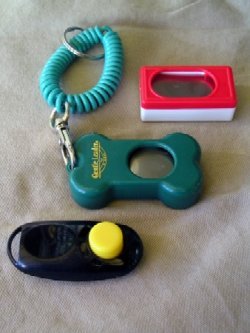
|
 |
 |
Clicker Dog Training: Step OneCharging the Clicker and a Few Other PointersPhoto courtesy Wikimedia Commons Ready
for your clicker dog training adventure? Can't wait to get
started? There is one critical step you need to take before
training your dog with this method--charging the clicker. Ready
for your clicker dog training adventure? Can't wait to get
started? There is one critical step you need to take before
training your dog with this method--charging the clicker. If you've read my first clicker dog training article you know that clicker training uses the scientific approach of classical conditioning. But, instead of ringing a bell like Pavlov, you'll use your clicker to let your dog know a treat is coming. So, you need one or two preliminary sessions to teach your dog to associate the sound of the click with getting a treat. Most dogs catch on very quickly. Here's how it goes. . . Take your dog to an area with few if
any distractions. Don't give
your dog any commands--just click and treat. Then do
it again-click/treat, click/treat, click/treat and so on several
times. Take a short break. Maybe five minutes. Then
click and treat again. If your dog starts looking for a treat
when he hears the click, you'll know he's making the connection.
Once you think he's "getting it", end the session. It's not a bad idea to repeat the exercise a few hours or a day later. You want to make sure the connection between the click and the treat is firmly established in your dog's mind. That's it! You are now ready to begin clicker dog training in earnest. You may be asking yourself at this point, "Do I really need a clicker? Can I just say 'good dog' and treat instead of using the clicker?" Well, you could. But your mileage may vary. The clicker as a training tool provides a consistency of sound and pitch that the human voice does not. Also, if you find yourself saying your cue phrase--"good dog!", "right!", "yes!", etc.--when you aren't training and don't have treats available, your dog could become confused and the cue phrase could lose its potency. Clickers are very inexpensive. The fancier ones are mostly under $2 and some pet supply stores have been known to put their logo on the back of the basic plastic box type and give them away for free. Finally, here are a few tips to help you on your way with the clicker dog training experience beyond charging the clicker: Treats
The Clicker
|
|
|
|
[?] Subscribe To This Site

|
||
 |
||
|
| ||





